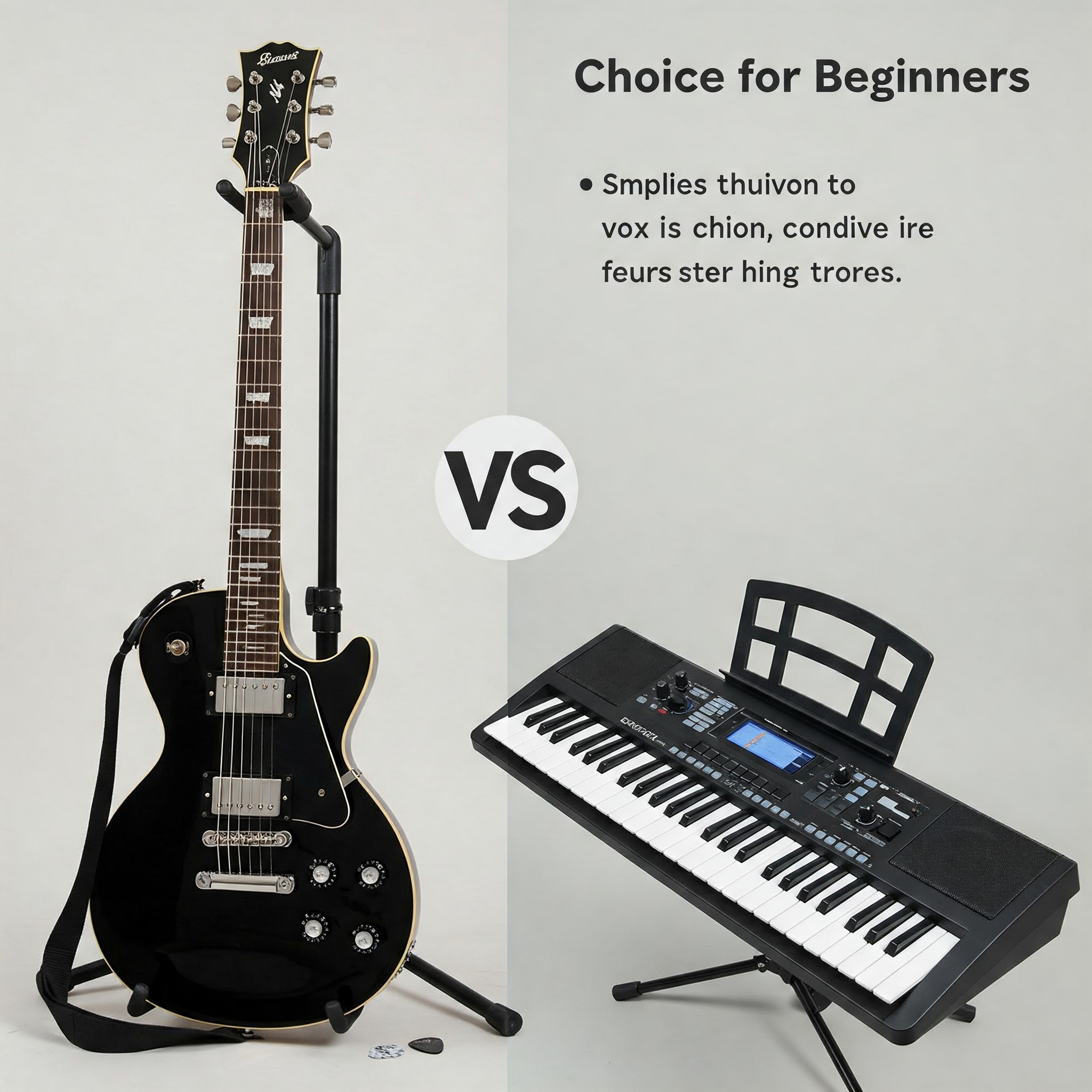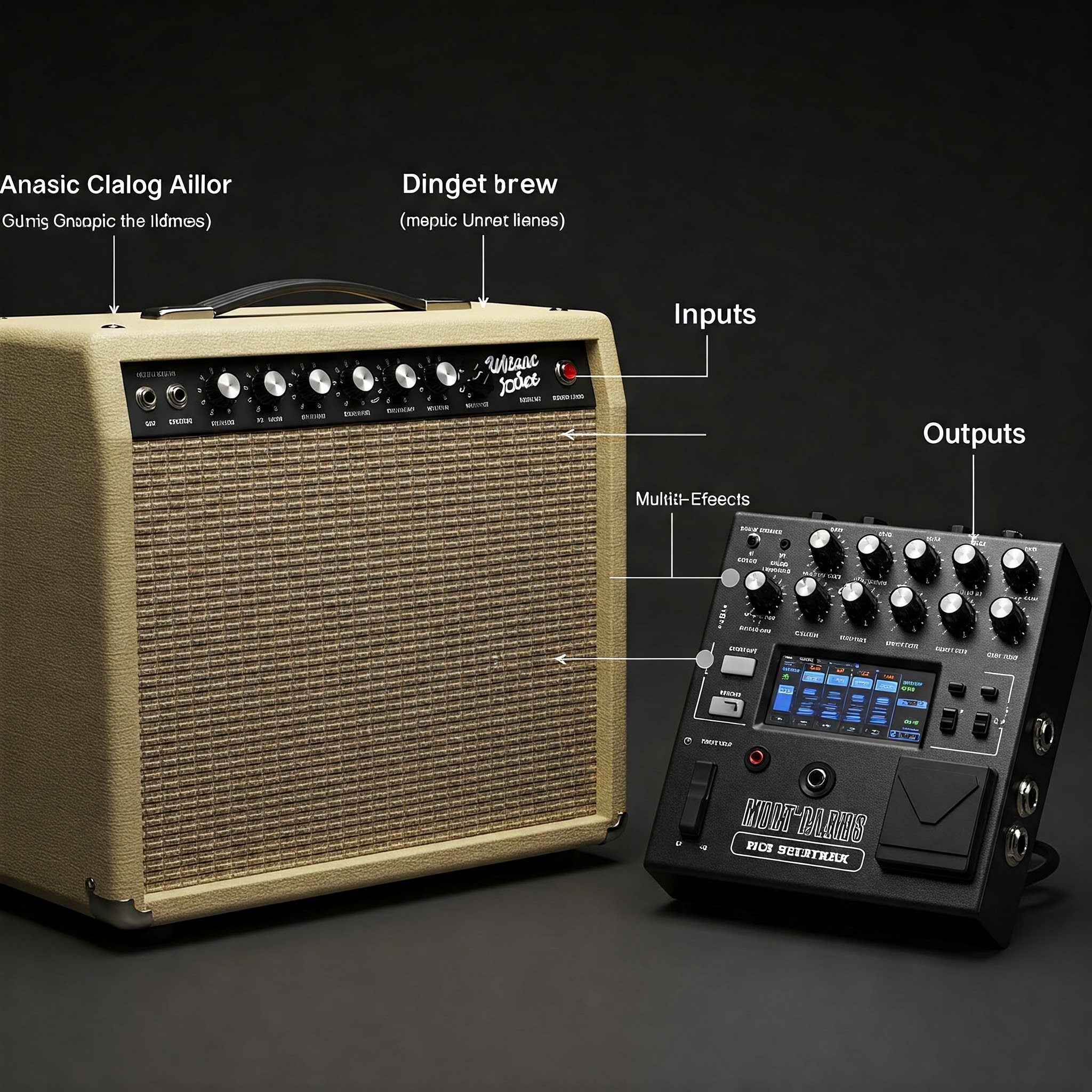Are you wondering about the key differences between a beginner guitar vs intermediate guitar? Perhaps you’ve been playing for a while and are curious if it’s time to upgrade your instrument, or maybe you’re just starting out and want to understand what lies ahead on your musical journey.
✨Was this helpful? Spread the word! 🚀
As someone who’s spent over 15 years teaching guitar and watching students progress from hesitant beginners to confident intermediate players, I’ve witnessed firsthand how the right instrument at the right time can make all the difference. The transition from beginner to intermediate status is an exciting milestone for any guitarist, often accompanied by questions about equipment upgrades, technique refinements, and skill development.
In this comprehensive guide, we’ll explore the fundamental differences between beginner and intermediate guitars, how to know when you’re ready to upgrade, and which specific instruments might be worth considering at each stage. We’ll also look at how your playing technique and practice habits should evolve as you advance.
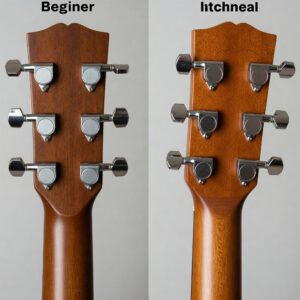
Understanding Guitar Progression Levels
Before diving into the equipment differences, let’s clarify what typically defines beginner, intermediate, and advanced guitar players. Understanding where you fall on this spectrum can help you make more informed decisions about your instrument needs.
Beginner Guitarist (0-1 years)
✅ Learning basic chords and simple strumming patterns
✅ Developing calluses and finger strength
✅ Playing simple songs with open chords
✅ Understanding basic music theory
✅ May struggle with smooth chord transitions
✅ Typically practices 15-30 minutes per session
Intermediate Guitarist (1-3 years)
✅ Comfortable with barre chords and power chords
✅ Can play scales and simple solos
✅ Developing ear training abilities
✅ Understanding more complex music theory
✅ Can learn songs more quickly
✅ Typically practices 30-60 minutes per session
✅ Beginning to develop personal style
Advanced Guitarist (3+ years)
✅ Mastery of complex techniques (sweep picking, tapping, etc.)
✅ Comfortable improvising
✅ Deep understanding of music theory
✅ Can play in multiple styles fluently
✅ Often creates original music
✅ Practices 1+ hours regularly
According to a study by Fender, nearly 90% of beginner guitarists abandon the instrument within the first year. The transition from beginner to intermediate level is therefore a crucial milestone that represents significant dedication and progress.
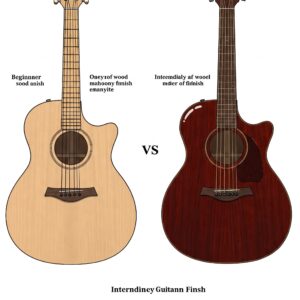
Key Differences Between Beginner and Intermediate Guitars
When comparing beginner guitar vs intermediate guitar options, several key differences emerge in terms of construction, components, and overall quality:
1. Wood Quality and Construction 🪵
Beginner Guitars:
- Often use laminated woods or wood composites
- May utilize less expensive tonewoods like basswood or agathis
- Generally feature simpler construction methods
- Less attention to fine details in finishing
Intermediate Guitars:
- Feature solid woods, particularly for soundboards on acoustic guitars
- Utilize higher quality tonewoods like alder, ash, or mahogany
- More sophisticated construction techniques
- Greater attention to detail in finishing work
According to research from Taylor Guitars, the wood selection can account for approximately 30% of a guitar’s overall tonal character, making this a significant upgrade when moving to intermediate instruments.
2. Hardware Components ⚙️
Beginner Guitars:
- Basic tuning machines with higher gear ratios (less precise)
- Simpler bridge designs
- Standard nut materials (often plastic)
- Basic electronics (if electric)
Intermediate Guitars:
- Higher-quality tuning machines with lower gear ratios (more precise)
- More sophisticated bridge systems that improve sustain and tuning stability
- Better nut materials (bone, TUSQ, or GraphTech)
- Improved electronics with better pickups and more tonal options
3. Playability and Setup 🎸
Beginner Guitars:
- May have higher action (string height)
- Often have wider string spacing for easier chord formation
- Sometimes have slightly shorter scale lengths
- Factory setup that’s “good enough”
Intermediate Guitars:
- Lower, more customized action
- More comfortable neck profiles suited to faster playing
- Professional setup options
- Better intonation along the entire fretboard
4. Tonal Quality and Range 🎵
Beginner Guitars:
- Adequate but often less complex tonal qualities
- Limited dynamic range
- May lack sustain or resonance
- Less balanced frequency response
Intermediate Guitars:
- Richer, more complex tonal characteristics
- Wider dynamic range
- Better sustain and resonance
- More balanced across frequency spectrum
5. Price Range 💰
Beginner Guitars:
- Typically $100-$300
- Great value for those starting out
- Less of a financial commitment
Intermediate Guitars:
- Typically $400-$1000
- Represents a significant investment
- Better long-term value as skills develop
6. Longevity and Maintenance 🔧
Beginner Guitars:
- May require more frequent setup adjustments
- Parts may wear more quickly
- Less likely to be kept for decades
Intermediate Guitars:
- More stable, requiring less frequent adjustment
- Components designed for longer life
- Often become lifetime instruments
7. Brand Considerations 🏷️
Beginner Guitars:
- Often from budget lines of major manufacturers
- May include brands specifically targeting beginners
Intermediate Guitars:
- Mid-range offerings from respected manufacturers
- Greater consistency in quality control
Let’s compare some specific aspects in a more detailed format:
| Feature | Beginner Guitar | Intermediate Guitar |
|---|---|---|
| Wood Type | Laminated/composite | Solid woods |
| Neck Profile | Thicker, more comfortable for beginners | Thinner, faster for advanced techniques |
| Fretwork | Basic, functional | Precise, polished |
| Tuners | Basic sealed tuners | Higher ratio, locking tuners |
| Electronics (Electric) | Stock pickups, basic controls | Better pickups, more versatile controls |
| Price Range | $100-$300 | $400-$1000 |
| Longevity | 2-5 years | 10+ years |
| Resale Value | Low | Moderate to good |
💬 Just one click – help others make better buying decisions too!😊

When to Upgrade from Beginner to Intermediate Guitar
Knowing when to make the transition from a beginner to intermediate guitar is crucial. Here are some signs that you’re ready for an upgrade:
Signs You’re Ready to Upgrade ⬆️
- You’ve been playing consistently for at least a year
- Basic techniques feel comfortable and automatic
- You can play barre chords cleanly
- You’re starting to learn more complex techniques
- You can hear limitations in your current instrument
- You’re committed to continuing guitar long-term
- You understand what you want in tone and feel
According to a survey by Guitar World, most guitarists upgrade their first instrument between 12-18 months after starting to play. However, this timeline can vary significantly based on practice frequency and natural aptitude.
The Right Time to Invest 📈
Making the jump to an intermediate guitar represents not just a financial investment but also a commitment to your development as a musician. As renowned guitarist and educator Justin Sandercoe notes, “The right time to upgrade is when your current guitar is holding back your progress rather than your skills.”
Balancing Budget and Quality 💲
While intermediate guitars cost more, they don’t necessarily need to break the bank. Many manufacturers now offer “sweet spot” models that provide significant upgrades in quality without reaching the premium prices of professional-level instruments.
Top Beginner Guitars Worth Considering
If you’re just starting your guitar journey, here are some excellent options that provide great value while supporting your early development:
For Acoustic Players
- Yamaha FG800 – This affordable dreadnought offers remarkable sound quality for beginners with a solid spruce top and comfortable neck profile. The Yamaha FG800 consistently receives high ratings for its projection and balance.
- Fender CD-60S – With a solid mahogany top and easy-playing neck, this model provides warm tones and excellent playability for new guitarists.
- Jasmine S35 – An ultra-budget friendly option that doesn’t sacrifice essential quality, making it perfect for absolute beginners unsure of their commitment level.
For Electric Players
- Squier Affinity Stratocaster – This affordable version of the iconic Stratocaster offers classic styling and versatile tones. The Squier Affinity Stratocaster provides a comfortable playing experience with its C-shaped neck profile.
- Epiphone Les Paul Special II – Offering the legendary Les Paul shape and dual humbucker configuration, this guitar delivers impressive rock tones at a beginner-friendly price point.
- Yamaha Pacifica PAC012 – With a versatile HSS pickup configuration and solid construction, this model offers exceptional value for beginners exploring different musical styles.
Why These Work for Beginners 🎯
These instruments share several characteristics that make them ideal for beginners:
- Comfortable neck profiles that facilitate learning
- Decent quality control despite lower price points
- Adequate components that don’t require immediate upgrading
- Versatile tonal options to explore different styles
Important Beginner Guitar Accessories ✨
When purchasing your first guitar, consider these essential accessories:
- Electronic tuner – Critical for developing proper ear training
- Extra strings – Breakage is common for beginners
- Basic gig bag – For protection during transport
- Picks of varying thickness – To explore different playing feels
Beginner Budget Considerations 💵
Most experts recommend allocating about 70-80% of your beginner budget to the guitar itself, with the remainder going to essential accessories. This ensures you get the best possible instrument without sacrificing necessary supplementary items.
💡 Upgrade Your Journey with Quality Basics! 🔥
➡ Whether you’re just starting out or preparing to upgrade, ensuring you have proper accessories makes a world of difference. Click on any of the highlighted products to check current pricing and availability on Amazon. These carefully selected items will support your practice sessions and help you develop proper technique from day one!
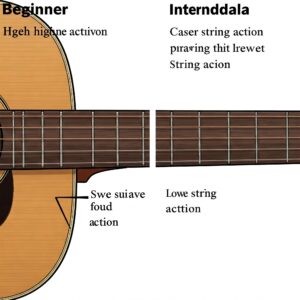
Best Intermediate Guitars for Advancing Players
As your skills develop, these intermediate-level instruments offer significant upgrades that will support your continued growth:
For Acoustic Players
- Taylor 114ce – This Grand Auditorium model features a solid Sitka spruce top and layered walnut back and sides, delivering balanced tone with excellent projection. The Taylor 114ce includes ES2 electronics for high-quality amplified performance.
- Martin DJr-10E – A smaller-bodied guitar with premium features including solid sapele top and Fishman electronics. The shorter scale makes it comfortable while still delivering the characteristic Martin tone.
- Seagull S6 Original – Made in North America with a solid cedar top and wild cherry back and sides, this guitar offers distinctive warm tones and exceptional build quality.
For Electric Players
- Fender Player Stratocaster – Made in Mexico, this authentic Fender offers significant upgrades over beginner models with improved pickups, better tuning stability, and superior craftsmanship. The Fender Player Stratocaster delivers the classic Strat tone beloved by guitarists across genres.
- PRS SE Standard 24 – Featuring PRS’s distinctive design and dual humbucker configuration, this guitar offers premium features at an intermediate price point.
- Ibanez AS73 – This semi-hollow body electric provides versatility across jazz, blues, and rock with its warm tone and comfortable playability.
What Makes These Worth the Upgrade 🚀
These intermediate guitars offer several significant improvements:
- Better tonewood selection that improves resonance and sustain
- Superior electronics that provide more tonal options
- Enhanced playability through better neck profiles and fretwork
- Improved tuning stability with higher-quality hardware
- More consistent manufacturing with tighter quality control
The Long-Term Value Proposition 📊
While the initial investment is higher, intermediate guitars typically offer better value over time because:
- They remain playable and enjoyable as your skills advance
- They maintain better resale value if you decide to upgrade further
- They require fewer upgrades or modifications
- They typically last longer with proper care
According to research from Reverb.com, intermediate guitars typically retain 60-70% of their value after 3-5 years, compared to only 30-40% for beginner models.
Playing Techniques: Beginner vs Intermediate
As you progress from beginner to intermediate status, your approach to guitar playing naturally evolves. Here’s how techniques typically develop:
Beginner Techniques 🔰
- Basic chord shapes (A, C, D, E, G)
- Simple strumming patterns
- Basic picking techniques
- Fundamental rhythm concepts
- Simple song structures
Beginners typically focus on building fundamental muscle memory and basic musical understanding. The goal at this stage is consistency and clean execution of basic techniques.
Intermediate Techniques 🏆
- Barre chords across the neck
- More complex strumming and picking patterns
- Beginning lead techniques (bends, vibrato, hammer-ons, pull-offs)
- Basic improvisation skills
- More sophisticated rhythm techniques
- Introduction to specialized techniques (palm muting, harmonics)
Intermediate players begin developing more personalized approaches to the instrument, exploring techniques specific to their preferred musical styles.
Technical Focus Areas by Level
| Skill Level | Primary Focus | Secondary Focus | Common Challenges |
|---|---|---|---|
| Beginner | Clean chord transitions | Basic timing | Hand fatigue, buzzing notes |
| Intermediate | Technique expansion | Style development | Speed limitations, complex rhythms |
| Advanced | Technical mastery | Musical expression | Advanced concept integration, originality |
🔥 Elevate Your Practice With Professional Tools! 🎸
➡ Ready to take your practice to the next level? The right equipment makes all the difference in developing proper technique. Click on any highlighted product to find current pricing and availability. These professional-quality tools will help you build skills faster and more effectively!
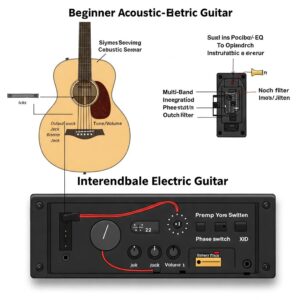
Practice Routines for Different Skill Levels
Your practice routine should evolve as your skills develop. Here’s how effective practice differs between beginner and intermediate levels:
Beginner Practice Routine (30 minutes) ⏱️
- 5 minutes: Warm-up with basic finger exercises
- 10 minutes: Chord practice and transitions
- 10 minutes: New song work
- 5 minutes: Review of previous material
Beginners benefit from shorter, more frequent practice sessions that build finger strength and basic muscle memory without excessive fatigue. According to research from the University of Texas at Austin, distributed practice (shorter, more frequent sessions) leads to better skill acquisition for beginners than massed practice (longer, less frequent sessions).
Intermediate Practice Routine (60 minutes) ⏱️
- 10 minutes: Technical warm-up (scales, finger exercises)
- 15 minutes: Technique development (specific skills)
- 20 minutes: Song work (learning and refining)
- 10 minutes: Improvisation practice
- 5 minutes: Ear training
Intermediate players can handle longer practice sessions and benefit from more focused technical work. At this stage, deliberate practice—focusing on specific challenging areas—becomes more important than simply accumulating playing time.
Practice Tools by Level 🧰
Beginner Tools:
- Basic metronome
- Simple chord charts
- Beginner method books
- Basic tuner
Intermediate Tools:
- Advanced metronome with subdivision options
- Backing tracks for improvisation
- Scale and mode references
- Recording equipment for self-evaluation
- More sophisticated teaching resources
As noted by the Journal of Research in Music Education, the quality of practice is consistently more important than quantity across all skill levels, but the definition of “quality practice” evolves as players advance.
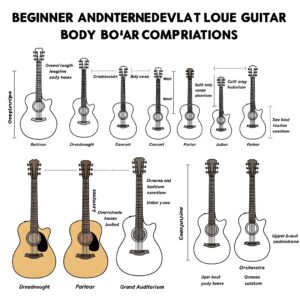
Frequently Asked Questions
How much should I spend on a beginner guitar vs intermediate guitar?
For beginner guitars, a budget of $150-$300 is typically sufficient to get a quality instrument that won’t hinder your development. For intermediate guitars, expect to invest $400-$1000 for an instrument that will continue to meet your needs as you advance. According to industry experts, the “sweet spot” for value in intermediate guitars is typically around $600-$800.
Should I choose an acoustic or electric guitar as a beginner?
This largely depends on your musical preferences. Acoustic guitars are often recommended for beginners because they’re more portable, require no additional equipment, and build finger strength more quickly. However, if you’re primarily interested in styles that use electric guitar, starting with an electric can help maintain motivation. The slight additional complexity of amplification is offset by the typically lower string tension, which can be easier on beginner fingers.
How do I know if a guitar is really “intermediate quality”?
Beyond price point, look for these indicators of intermediate quality:
- Solid woods rather than laminates (particularly important for acoustic tops)
- Name-brand tuning machines
- Bone or synthetic bone nut and saddle (for acoustics)
- Quality pickups with good output (for electrics)
- Consistent, clean fretwork
- Stable tuning that lasts through playing sessions
Should I upgrade my beginner guitar or buy an intermediate model?
This depends on the specific limitations of your beginner instrument. In most cases, purchasing an intermediate guitar is more cost-effective than significantly upgrading a beginner model. As noted by Guitar Player Magazine, upgrades to beginner guitars often cost 50-70% of the price of a new intermediate instrument while only achieving 40-60% of the quality improvement.
Can a good guitar make me play better?
While no instrument can replace practice and dedication, a better guitar can certainly facilitate improvement by:
- Staying in tune more consistently
- Having better intonation across the fretboard
- Offering easier playability that reduces fatigue
- Providing more inspiring tone that increases practice motivation
- Requiring less compensation for instrument limitations
Conclusion
The journey from beginner to intermediate guitarist is marked not just by skill development but also by an evolution in equipment needs. The differences between beginner guitar vs intermediate guitar options reflect this progression, with intermediate instruments offering significant improvements in construction, playability, and tonal qualities that support more advanced techniques and musical expression.
While beginner guitars focus on accessibility and learning comfort, intermediate guitars emphasize performance capabilities and tonal refinement. Understanding when you’re ready to make this transition can help ensure that your instrument continues to support rather than limit your musical growth.
Whether you’re just starting out or preparing to take the next step in your guitar journey, remember that the best instrument is ultimately the one that inspires you to keep playing. The right guitar at the right time can make the difference between abandoning the instrument and developing a lifelong musical passion.
🌟 Take Your Playing to New Heights! 🎵
🙄 Ready to upgrade your guitar journey? The perfect instrument makes all the difference in your musical development. Click on any highlighted recommendation to check current pricing and find the ideal guitar that matches your skill level and musical aspirations!
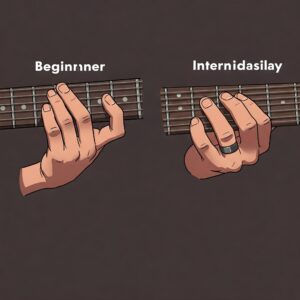
More FAQ
❓ What’s the main difference between beginner and intermediate guitars?
✅ Beginner guitars are typically more affordable with basic features, while intermediate models offer better tonewoods, hardware, and playability for advancing skills…
❓ How do I know if I need to upgrade from a beginner guitar?
✅ If you're playing more complex songs, noticing sound limitations, or struggling with tuning stability, it’s time to move up to an intermediate guitar…
❓ Are intermediate guitars worth the extra cost?
✅ Yes, intermediate guitars offer better sound quality, durability, and performance, making them a smart long-term investment for serious learners…
❓ Can beginners use intermediate guitars?
✅ Beginners can start with an intermediate guitar if the budget allows; higher-quality instruments can improve learning comfort and sound satisfaction…
❓ What features should I look for in an intermediate guitar?
✅ Look for solid wood construction, better pickups (for electric), smooth fretwork, and reliable tuning machines to match your growing skill level…
Recommended for You:
- Guitar vs Ukulele: 7 Surprising Differences & How to Choose Your Perfect Musical Companion
- Nylon Strings vs Steel Strings: The Ultimate Guide to Choosing the Right Guitar Strings in 2025
- Yamaha vs Ibanez Acoustic Guitars: The Ultimate Comparison Guide for 2025 – Honest, In-Depth & Expert-Picked Insights
Disclaimer: This article contains affiliate links. If you purchase products through these links, we may earn a small commission at no additional cost to you.
✨ Found this helpful? Share it with your friends! 💬🤗


